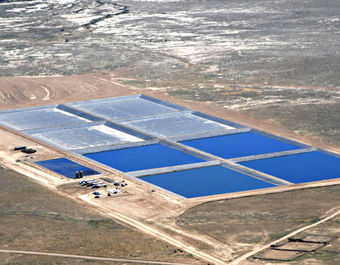 Oil
and gas wastewater facility run by Danish Flats
Environmental Services in Eastern Utah. The process
uses open pits that allow the contaminated water to
evaporate into the air. Danish Flats was fined
$50,000 recently for releasing excessive emissions
from its pits. Credit: Danish Flasts Environmental
Services
Oil
and gas wastewater facility run by Danish Flats
Environmental Services in Eastern Utah. The process
uses open pits that allow the contaminated water to
evaporate into the air. Danish Flats was fined
$50,000 recently for releasing excessive emissions
from its pits. Credit: Danish Flasts Environmental
Services A commercial facility that disposes of oil and gas waste in Eastern Utah has been fined $50,000 for releasing excessive amounts of benzene and other volatile organic compounds without a state air emissions permit.
Rusty Ruby, compliance manager for Utah's Division of Air Quality Compliance, said the agency doesn't have "a lot of experience" when it comes to regulating waste pits because so little is known about them, a problem common in other states where hydraulic fracturing is generating vast quantities of contaminated waste water.
"It's not like a smokestack that you can get a pretty good idea of what's coming out," Ruby said.
In this case, the violation became clear when Utah officials discovered that Danish Flats Environmental Services had nearly doubled the size of its operation without obtaining an emissions permit. Ruby said the Colorado-based firm's unpermitted operation was exceeding emissions regulations under the federal Clean Air Act and state law.
Calls to Justin Spaeth, the company's operations manager, were not returned.
When Danish Flats began operations in 2008, it was small enough that its pits didn't require air emission permits, Ruby said. But the facility grew from eight to 14 ponds and—at the height of its operation—took in more than 5 million gallons of contaminated oil and gas waste water a year, according to the company's website and state figures. That’s when the company should have applied for a permit, Ruby said.
Volatile organic compounds, including benzene, toluene, and xylene, are released from that waste, according to the company's recently filed permit application. The process uses open pits that allow the contaminated water to evaporate into the air.
Trying to establish a baseline for waste pit emissions is difficult because emissions can be elusive, Ruby said. "You can take a sample from the pond one day and it shows emissions are de minimis and take a sample the next day that shows emissions are pretty high."
Ruby said the state has not been able to establish definitive standards for waste pits because emissions fluctuate so widely and often.
"We had to think of what would be representative levels that we could use to establish a standard. That's been hard to do."
© InsideClimate News
http://insideclimatenews.org/news/20140903/oil-and-gas-wastewater-pits-draw-fine-toxic-releases